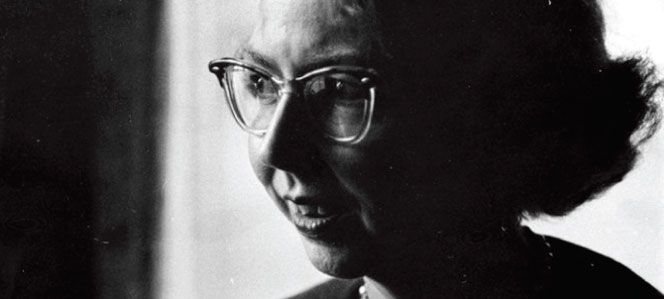She didn’t waste a word. That’s how many critics describe Flannery O’Connor’s fiction. It’s also an apt description for Angela Alaimo O’Donnell’s new biography on O’Connor. In one hundred and twenty-four pages, O’Donnell offers a well researched, highly readable, succinct, and reverent presentation of Flannery O’Connor’s life and work. If you’ve been looking for a nice introduction to O’Connor this summer, look no further. This is your book.
O’Donnell gladly admits in the introduction that this thin volume owes a great debt to the two most prominent O’Connor biographies – Paul Elie’s The Life You Save May Be Your Own: An American Pilgrimage and Brad Gooch’s Flannery: A Life of Flannery O’Connor. (If you have the time to read almost 1,000 pages this summer, then go immediately to Elie and Gooch, but if not, O’Donnell will more than suffice.) Flannery O’Connor: Faith Fired by Fiction is part of Liturgical Press’s new series, People of God, which is comprised of short biographies of twentieth- or twenty-first-century Catholics geared toward the general reader. Ironically, O’Connor once wrote that she thought that, “the average Catholic reader was a Militant Moron.” I will assume, however, that the readers of this pithy review are above average.
Mary Flannery O’Connor was born in Savannah, Georgia on March 25, 1925 – the Feast of the Annunciation – to Edwin and Regina Cline O’Connor. Her birthday is significant, as O’Connor’s fiction is unapologetically and unmistakably Incarnational. The family home was located in the Catholic ghetto of Lafayette Square, literally in the shadow of St. John the Baptist Cathedral where Flannery couldn’t help but be formed by the rhythm of liturgical life – Angelus bells, Eucharistic processions, Feast days, May Crownings, etc. Her parents were both devoutly Catholic, and their faithful influence would mark Flannery for life.
The brilliance of O’Donnell’s presentation of Flannery O’Connor is that she is able to tell O’Connor’s life story while at the same time offering literary commentary on O’Connor’s fiction. When describing O’Connor’s childhood, O’Donnell references “A Temple of the Holy Ghost”, when commenting on her life at Andalusia, she looks to “The Life You Save May Be Your Own”, and in presenting O’Connor’s final year of life, she turns to “Revelation”. My only warning would be that O’Donnell deals a lot of spoilers, so you might want to read the aforementioned stories first.
In describing the People of God series, to which this O’Connor biography is part, the folks at Liturgical Press state that the point of this series is to offer “a credible and concrete witness of faith, hope and love to people of our own day.” O’Donnell does a masterful job at showing O’Connor’s credible and concrete witness to her faith by her daily disciplines of personal prayer, mass, and spiritual reading, which began in Savannah and followed her throughout her life to Atlanta, Iowa, New York City, Connecticut, and back to Milledgeville, not to mention her intentional community of Catholic friends, her role as an Catholic apologist, and one of the wittiest letter-writers America has known.
O’Donnell also offers a very fine treatment of the role of suffering in O’Connor’s life, who lost her father to lupus, the same disease that would eventually take her life at the young age of thirty-nine. She also adequately and honestly addresses Flannery O’Connor and the issue of race, which has been the point of some controversy over the years. The only real omission I found in O’Donnell’s book would be that of O’Connor’s friendship with Elizabeth Hester. O’Donnell does mention the friendship between O’Connor and Hester, but she doesn’t address the fact that Hester was a lesbian, who was dishonorably discharged from the Air Force. O’Connor’s pastoral care and love of her good friend Elizabeth can be a model for every faithful Catholic, especially today.
Flannery O’Connor: Fiction Fired by Faith can be read in one sitting, over a few days, on a priest’s day away, on a long flight, before bed, or even on the beach. (I read most of my copy in the atrium at the Cleveland Museum of Art.) It’s a great little book that will fire your faith and introduce you to one of the most mysterious, beautiful, humorous, intelligent, prophetic, and faithful Catholics of the twentieth-century.
